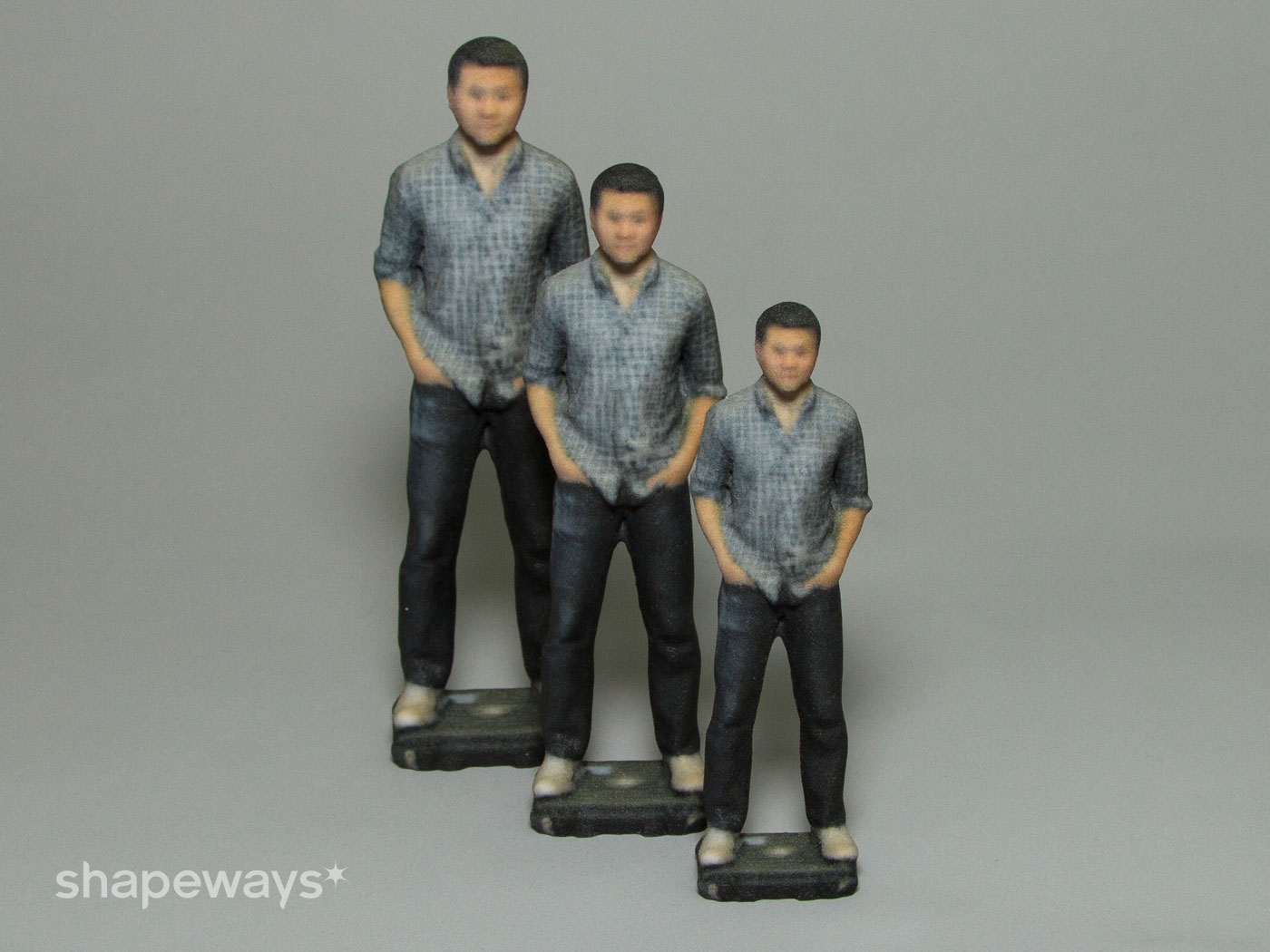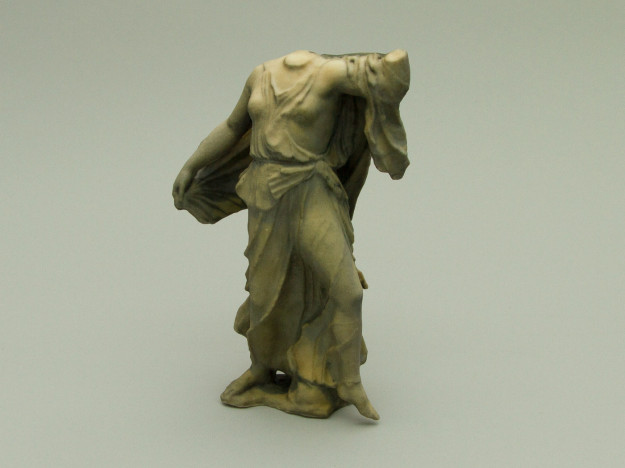
Today Shapeways is growing our suite of 3D tools by launching the ability to scale your model to different sizes during the upload process. This enables greater flexibility for you to purchase models at the price you want and to remedy common printability problems like thin walls and bounding box errors on-site. You will have the option to scale your model by dimension and percentage in two different locations: the Model Edit page so you can see how pricing changes after scaling and within 3D tools for when you are trying to improve the printability of your model.
Scaling empowers you to quickly and proportionally resize models to exact specifications so art, home items, games, and other products can be adjusted without using 3D software and then having to re-upload the model.
Scaling can be used by experienced designers and is easy enough for beginner designers and modelers with limited to no modeling experience. For example, the availability of 3D scanned people, monuments, art, and objects of all sizes available on sites like Sketchfab offer a new source of 3D printable content and inspiration. Now, with the option for simple, straightforward scaling that requires no modeling experience, novice to experienced designers can make incredible scanned data like an ancient statue come to life in a size that can fit in your home – and fit in our 3D printers.
Bringing scanned content to life
Sketchfab designer Nebulousflynn’s scanned model of one of the daughters of the sea-god Nereus from the Nereid Monument constructed in 390-380 BC is well over 5 feet (or ~1.52 meters). Using the new scaling tool on Shapeways, you can reduce its from a statue that would take considerable space in your living room to a stunning miniature in full colored sandstone you can place on your bookshelf. Simply download the model like this from Sketchfab, upload it to Shapeways, scale it down – and we will 3D print it!

Scanned model of one of the daughters of the sea-god Nereus from the Nereid Monument by Nebulousflynn, a designer at Sketchfab
Printability plays a key factor in determining what size to print a scanned model. If the scanned model contains thin walls, you can increase the size of the model within 3D tools to thicken the walls while checking on the bounding box to ensure you aren’t making it too big to print in your desired material. Increasing the size can also ensure that small details are visible. Humanti’s statue of a woman carrying a harvest, Heykelhigh2suport, presents a great example of bringing existing scanned data to life, while making sure that the model is large enough to show all the details that make it beautiful.
Finding the right scanned model to work with when considering file formats, model completeness, licensing and attribution, and other factors can sometimes make 3D printing a scanned model tricky. Check out our tutorial to help you navigate these considerations.
Empowering entrepreneurs with greater pricing and model size consistency
For entrepreneurs who are using 3D scanning to capture new models, scaling offers additional controls to price and size products consistently. Scanned data often introduces a lot of variability, especially when you are scanning people, because every individual is unique. This creates variability in the cost per printed miniature person; with scaling, as long as you maintain the printability of the model, you can adjust the size of miniatures to create greater cost consistency. Or, if size consistency is more important, you can make each miniature exactly the same height.

Three printed scans of Dan in full color sandstone in different sizes: from front to back, 10.5cm tall, 12.5cm tall, and 14.5cm tall.
To demonstrate this, we scanned and printed one of our team members Dan using Skanect, a 3D scanning software made by our partners Occipital. Skanect makes it very easy for users to scan and prep models for 3D printing using a variety of scanning hardware, including Occipital’s own Structure Sensor, and allows you to scale your model by percentage when uploading to Shapeways. Together, scaling on Shapeways and Skanect allow you to confidently and consistently offer and print your scans at the size or price you want. We printed Dan in three different sizes at three different price points to show how easy it can be.
It’s important to remember that changing the size of a model will always impact both the price and the printability of your model. Check 3D tools after you scale a model to ensure that your new model is printable and you are aware of any changes to how your model may be printed. Also remember that when you scale your model, it will be saved as a new version of your model which will not carry over any printability data. This means if you scale an existing “For Sale” model, and scale it to a different size, it will have ‘First to Try’ status.
We hope you enjoy this new tool. Upload a new model or use one of your existing models to try scaling today!





Hurray! This is fantastic news for jewelers. Now I can scale all my ring sizes easily. 🙂
FINALLY! – This is something that I have requested for years! Makes it SO much easier to make final tweaks to size/price AND as a bonus to Shapeways it frees up your servers from users like me constantly uploading new variations of models with slight size changes…
The devil is in the details.
Speak up, you down there…
HURRAH!!!!!!
I have better scaling in PC soft. What is possibility about? Buyers still not able to order ring/bracelet in needed size.
They can order in any size they want – as long as YOU create the model that they can order from. And with this new scaling method that makes it a whole lot easier.
OMG I have been waiting to have something like this. Thank you
this is great! i’ve been asking for this for a long time
Can we have the option to scale items as purchasers of other people’s models please?
This helps creators who are responsive enough to scale stuff for us, but doesn’t help if the creator doesn’t want to list different sized items or is simply unresponsive!
Love the new tool. Still a few bugs in it. I notice there a slight difference in the input screen to the webpage screen. The other two thing that help go along with this. Is I know parts will split off when shrinking down. For me not big thing. It like when we do toys and translate from 1/6 scale down to maybe 1/64 scale. We loose parts because thickness for a mirror bracket to small. So that why one big questions we get ask why no mirrors on some hotwheels? or other little details.
One thing that help is when these parts do separate when they shrink down the option to delete them from the site. Instead me having to re-down load re-up load again and again. When I go to the count portion of tools. Sometimes the crop tool does not work. Because of a over hang.So I can not crop out the loose part. Darn got re-download it or try to remember which part to cut off. Then upload it. If the count tool all ready identify these parts. should be a way to individually delete them too.
Next on the wall thickness tool. That automatic fix tool does not all way work right. Again if the program can identified these areas. Then should be yeah I know it headache to code. But be just to click on the heighted lighted yellow areas. and then click on slide with the option invert or push out. Where I end up with the biggest problem is the gun tube on tanks. When does the automatic wall thickness. it most time break up the gun tube. Or around edges it will over gross a area. Then here I go again having to remember or re-down load again. Thank goodness I got poser. It has tool like I describe to fix problem areas
But other then that love the new tool. Save me a lot of time. Thanks..